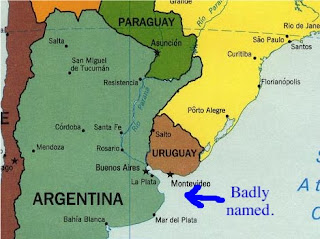This is mate (pron: MAH-tay):
It´s a kind of tea that you find in the southern half of South America - Paraguay, Uruguay, Brazil, Argentina, and I assume probably Chile. You fill up the gord-looking container with loose leaves, then stick in the metal straw, then pour in hot or ice-cold water depending on the temperature outside and suck it out. The gord holds a couple ounces of water, and when you´re done, you fill it up again and pass it to the next person.
At least that´s how you do it in Paraguay, which is where I learned to drink the stuff. It turns out that every country down here has its own way of perparing and drinking mate, and that in the collective eyes of each nation, everybody else is doing it like idiots.
Paraguayans drink mate pretty much as outlined above: pour in leaves, add boiling hot water, suck it out through a blistering metal straw. Your lips and tongue will get used to being burnt. Too hot for you? Maybe you´d prefer a bottle of baby formula. Paraguayan mate is the equivalent of Marlboro reds. Not for the faint of heart.
When I showed up in Argentina after working in Paraguay and made mate in a hostel, I passed it to one of the hostel workers, and she spit it out with a gasp asking why I had done it wrong and used such hot water. Argentineans set the gord and straw up the same way, but use reasonable temperature water. Marlboro lights. They also have more available brand variety in their mate leaves, as unlike Paraguay they actually trade with their neighbors, so you can intersperse your Marlboro lights with the occasional Camel light, Spirit light and Kool.
But Uruguay is a whole new bucket of BS. I tried making mate outside a bus station here the other day, and was promptly stopped, sat down and given a stern talking to by a passing pair of old men, as I was doing it entirely wrong and was clearly in need of tutelage. Setting up a mate gord here is a serious process. You pour in the leaves, cover the gord with your hand and slant the leaves, you pour in cold water over half the leaves and let it sit for a minute, then you pour in hot (but not too hot) water over the same half and let it sit for a minute, then you push the still-dry leaves up to make a ledge along one side of the gord, then you cover the end of the straw with your hand...
By the time they were done I didn´t want mate anymore, and I have no doubt that if I carried my newfound Uruguayan mate-making knowlege into Paraguay tomorrow I´d be sat down by two men at a bus station and told I was doing it like a fool. Then they´d notice how tepid my water was and call me a prettyboy.
Uruguayan mate is like rolling your own smokes. With filters. And crumbly, old, dry tobacco leaves that won´t stay in the paper. It´s difficult, it´s complicated, and in the end its no better than buying prerolled smokes.
For my money, Paraguayans do mate right: simple and painful, with a minimum of mucking around. In the battle for the title of Greatest Guay, this one goes to Paraguay.
As an aside, it´s not a coincidence that I use cigarettes as an analogy for different mate styles. I submit that mate is the perfect quit-smoking aid for the person who isn´t addicted to nicotine, but smokes because they need something to do with their hands and an excuse to stop working every few minutes. Folks down here drink mate pretty much exactly the same way we smoke up in the States: every hour or so you take a break from work, step outside for a couple minutes and pass around the gord. It´s highly caffeinated, so you get a decent buzz, but aside from the caffeine I´ve never heard anything to intimate drinking the stuff is bad for you in any way. It works for me: every time I feel like I could use a cigarette down here I just pull out my gord and thermos of hot water and go to town.
In the States, there might also be the added benefit that a mate gord with inserted straw looks, to someone who doesn´t know what it is, pretty illicit. It doesn´t look like a cup of tea, it looks like something out of a 1920´s San Francisco opium den. If you´re outside smoking a cig, there´s a decent chance some doof is going to come up and ask to bum one. If you´re outside sucking on what looks like an opium pipe...you´re going to get some personal space. And if someone DOES come up and ask for a hit off what they think is an opium pipe, well they were probably someone you would have wanted to meet anyway.







